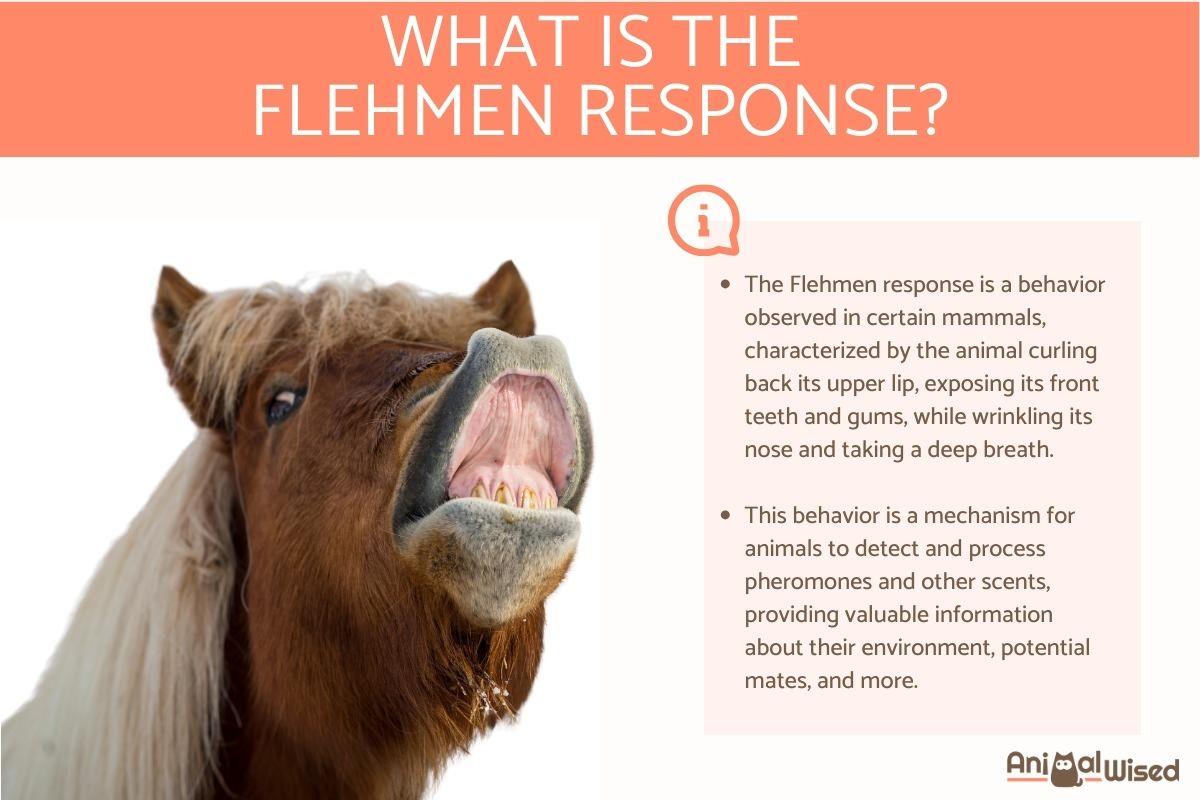What Is the Flehmen Response?


Have you ever seen a cat curl back its upper lip and expose its front teeth and gums? Or a horse wrinkle its nose and take a deep breath, with its mouth slightly open? This behavior may seem strange, but it has a very important purpose: to help animals detect and process pheromones and other scents.
In this AnimalWised article, we will explore the Flehmen response in detail. We will discuss what it is, how it works, and why it is so important to animals. We will also look at some examples of how different animals use the Flehmen response.
What is the Flehmen response?
The Flehmen response, also known as the Flehmen response, is a curious behavior seen in some animals, such as horses, cats, dogs, and goats.
It involves the animal curling back its upper lip to expose its front teeth and gums, while also wrinkling its nose and taking a deep breath. This behavior may seem strange, but it has a very important purpose: to help animals better detect and process pheromones and other scents. Animals may perform the Flehmen response for several seconds or even minutes.
Pheromones are chemical signals that animals release into the air to communicate with each other. They can be used to mark territory, attract mates, or signal danger.
The Flehmen response helps animals to detect pheromones by drawing air into the vomeronasal organ, a specialized scent organ located in the roof of the mouth.
The Flehmen response was initially thought to be primarily a male sexual behavior, used by males to determine if a female is in heat. However, further research has shown that both male and female animals of all ages exhibit the Flehmen response, indicating that it serves a variety of purposes beyond sexual identification.
Furthermore, the Flehmen response is often accompanied by other behaviors, such as lip-smacking and tongue flicking.

Which animals exhibit the Flehmen response?
The Flehmen response is observed in certain mammals, and it serves a specific purpose tied to their unique sensory organ known as the vomeronasal organ. Let's take a closer look at some animals known to exhibit this intriguing response:
- Cats
- Tigers
- Lions
- Elephants
- Giraffes
- Bison
- Tapirs
- Goats
- Sheep
- Horses
- Flames
- Antelopes
- Hippos
- Rhinos
Interestingly, this sensory mechanism is not exclusive to mammals; it's also found in some reptiles and amphibians, such as snakes and salamanders. However, the way reptiles activate their vomeronasal organ differs from mammals, as they often use methods like sticking out their tongues.
How does the vomeronasal organ work?
The vomeronasal organ, also known as Jacobson's organ, is a sensory organ found in many animals, including cats, horses, elephants, and dogs. It is located in the roof of the mouth, behind the front teeth. The vomeronasal organ is responsible for detecting pheromones and is essential for many animals to survive and reproduce. For example, male horses use the vomeronasal organ to determine if a female horse is in heat. Male dogs use the vomeronasal organ to track the scent of female dogs. And lions use the vomeronasal organ to mark their territory.
How does the vomeronasal organ work?
The vomeronasal organ is connected to the nasal cavity by two small ducts. When an animal breathes in through its nose, air flows over the vomeronasal organ and the pheromones are detected. The pheromones then bind to specialized receptors in the vomeronasal organ and send signals to the brain.
The brain interprets the signals from the vomeronasal organ and triggers appropriate behavioral responses. For example, if a male horse detects the pheromones of a female horse in heat, he will be motivated to approach her and mate. If a dog detects the pheromones of a predator, he will be motivated to flee.
Humans do not have a vomeronasal organ, but we can still detect pheromones using our olfactory bulb, which is located in the front of the brain. However, our sense of smell is not as sensitive as that of many animals, and we do not consciously perceive pheromones.

How does the Flehmen response work?
When an animal encounters a scent, it uses the Flehmen response to enhance its chemical analysis. The process typically involves the following steps:
- Lip-Curling: the animal retracts its upper lip, exposing its front teeth and gums. This unique lip-curling action helps direct scent molecules toward the vomeronasal organ (VNO), where they can be thoroughly examined.
- Nasal wrinkling: simultaneously, the animal wrinkles its nose, creating a temporary passage for the scent molecules to reach the VNO. This nasal wrinkling further facilitates chemical detection.
- Deep inhalation: the animal takes a deep breath, drawing in the scents with the aid of the Flehmen response. This allows for a more concentrated sample of the scent to reach the VNO, maximizing chemical perception.
Inside the VNO, specialized sensory cells are poised to identify and interpret the chemical signals. When scent molecules reach these receptors, they trigger neural signals that are transmitted to the brain for processing.
This chemical information is then decoded, providing the animal with valuable insights into its surroundings, such as the presence of potential mates, competitors, predators, or prey. Depending on the nature of the detected scent, the animal may exhibit various behavioral responses.
Functions of the Flehmen response
As mentioned before, the Flehmen response helps animals to detect and process pheromones and other scents. It is used for a variety of purposes, including:
Communication
The Flehmen response plays a crucial role in chemical communication among animals. As mentioned earlier, it enables them to detect and interpret pheromones and scent markings left by other members of their species. By "tasting" these chemical cues, animals can glean information about the identity, health, and even emotional state of their counterparts. This communication aids in establishing social hierarchies, identifying potential mates, and marking territory.
In some cases, the Flehmen response is not limited to intraspecies communication but extends to interactions with other species. For example, it can be used to identify potential predators or threats in the environment, helping animals make decisions about safety and survival.
Reproduction
One of the most well-known functions of the Flehmen response is its involvement in reproduction. Males often use this behavior to detect whether a female is in estrus or "in heat." By sniffing the female's scent markings or genital region, males can assess her reproductive status and suitability for mating. This function is critical for successful mating and passing on their genes to the next generation.
In some species, the Flehmen response can also synchronize the reproductive cycles of females. When a male detects that a female is in estrus, it can trigger hormonal changes in both sexes, increasing the likelihood of successful mating and reproduction.
Survival
Beyond communication and reproduction, the Flehmen response aids in survival. Animals use this behavior to gather information about their surroundings. By analyzing scents left by other animals, they can determine the presence of potential predators, prey, or competitors in the area. This information guides their behavior, helping them avoid danger, locate food sources, or defend their territory effectively.
The Flehmen response can also serve as a tool for ensuring the survival of offspring. Adults may use it to assess the health and condition of newborns, confirming their ability to thrive. This behavior helps parents provide care and protection to their young, contributing to the overall survival of the species.
Dogs have a powerful sense of smell, and they use it to learn all sorts of things about the world around them. One way they do this is by sniffing each other's butts. To learn more about why dogs smell each other's butts and how they use their sense of smell to communicate and learn, read our article.
If you want to read similar articles to What Is the Flehmen Response?, we recommend you visit our Facts about the animal kingdom category.
- Weeks, J.W., Crowell-Davis, SL, & Heusner, G. (2002). Preliminary study of the development of the Flehmen response in Equus caballus. Applied Animal Behavior Science , 78 (2-4), 329-335.
- Hart, B. L. (1983). Flehmen behavior and vomeronasal organ function. In Chemical signals in vertebrates 3 (pp. 87-103). Boston, MA: Springer US.
- Bland, K.P., & Jubilan, B.M. (1987). Correlation of flehmen by male sheep with female behavior and oestrus. Animal behavior , 35 (3), 735-738.







